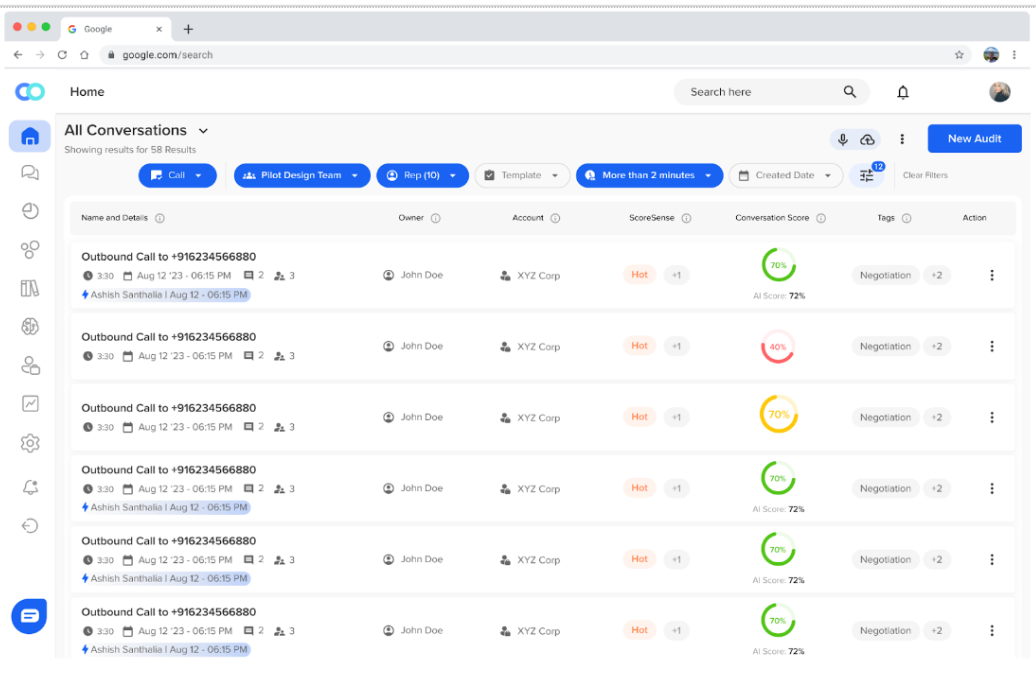Fraud in the insurance sector isn’t a glitch, it’s a structural drain. In the U.S. alone, losses due to fraud now exceed US $308.6 billion annually. Every policyholder pays the price via higher premiums or slower service, and for insurance executives, the stakes couldn’t be higher.
In this blog, you’ll get a clear breakdown of how deploying predictive analytics in insurance shifts the balance, from reacting to fraud to preventing it.
You’ll see how modern tools like AI‑driven call monitoring, machine learning insurance fraud models and real‑time fraud monitoring insurance workflows are powering results across auto, health and life lines.
Then we’ll walk you through how a solution like Convin ties these capabilities together for smarter fraud defense, and what that means for your bottom line.
Identify fraud blind spots with Convin’s risk intelligence tools
Why Predictive Analytics in Insurance Is Crucial for Fraud Prevention
In the highly competitive US insurance market, fraud isn’t a side‑issue. It’s a major threat to margins, policyholder trust and operational stability. According to one recent study, insurance fraud remains the second‑most costly white‑collar crime in the United States, after tax evasion.
Here’s why deploying predictive analytics in insurance matters now:
- Insurers using predictive analytics in insurance shift from reactive investigations to real‑time fraud prevention.
- The use of predictive analytics in insurance is projected to grow significantly, with a CAGR of 22% for fraud detection applications.
- When fraud goes undetected, costs get passed on: the average US family pays an extra US $400‑700 annually due to insurance fraud.
Leveraging predictive analytics in insurance means protecting losses before they hit the P&L, improving loss ratios and preserving premium affordability. The use of predictive analytics in insurance isn’t optional, it’s strategic.
1. Use of predictive analytics in insurance to detect early fraud signals
When a suspicious claim is submitted, timing matters. A recent study by CLARA Analytics found that advanced machine‑learning models could flag high‑risk claims as early as two weeks after the first notice of loss, significantly faster than traditional methods.
By embedding such early‑warning signals into your predictive analytics in the insurance framework, you shift from reactive investigations to proactive prevention.
The use of predictive analytics in insurance models ingest data such as claim metadata, agent interactions, and behavioural cues to detect anomalies before payouts occur.This means fewer false payouts, improved loss ratios and faster fraud intercepts.
2. How AI fraud detection insurance tools reduce false claims
Traditional rule‑based systems often miss novel fraud patterns and generate high false positive rates. According to Deloitte, firms using AI‑powered fraud tools could unlock savings of between US$80 billion and US$160 billion by 2032 in the U.S. fraud domain.
With the use of predictive analytics in insurance, AI fraud detection insurance tools combine voice, text, image and sensor inputs to filter out legitimate claims and flag suspicious ones. As a result, machine learning insurance fraud models learn from evolving tactics rather than static rules.
It means your team spends less time chasing noise and more time focusing on true high‑risk cases, boosting operational efficiency and reducing claims leakage.
3. Machine learning insurance fraud detection in the US market
Machine learning insurance fraud algorithms form the backbone of modern fraud prevention in the use of predictive analytics in insurance. For example, unsupervised models can detect cost‑outlier patterns or network relationships (e.g., provider‑attorney links) that indicate collusion. The CLARA Analytics study found 9 % of open claims flagged for Special Investigation Units by such algorithms.
More importantly, these models continuously refine themselves as new data, including agent‑call transcripts, claim histories and external behavioural feeds, is input.
For senior executives, the key takeaway is that machine learning insurance fraud models scale: they reduce dependency on manual rule‑updates and allow your predictive analytics in insurance programmes to adapt to tomorrow’s fraud schemes.
Preventing fraud begins with timing, but execution depends on technology. The systems behind predictive analytics are just as important as the strategy.
Shift your fraud ops from reactive to predictive with Convin AI
Technologies Driving Predictive Analytics in Insurance Fraud Detection
To successfully deploy the use of predictive analytics in insurance for fraud prevention, you need the right stack: data ingestion, modelling and real‐time monitoring.
1. Insurance analytics and real‑time fraud monitoring insurance models
Insurance analytics platforms enable the use of predictive analytics in insurance by ingesting diverse data, claims, policy info, call‑centre logs, behavioural signals, in a unified fashion. According to research, insurers analysed only 5 % of open injury claims under older methods, yet uncovered suspicious elements in 8 % of those using continuous monitoring. Risk & Insurance
Real‑time fraud monitoring insurance models then overlay live data streams to trigger instant alerts. This combination empowers senior leaders to detect fraud while the event is unfolding, rather than months later. For a head of business line, that means quicker triage, fewer degraded tickets and stronger policyholder trust.
2. How machine learning insurance fraud tools refine detection accuracy
When you feed your predictive analytics in an insurance system with high‑quality labelled data (such as flagged calls, behavioural anomalies, flagged claims), machine learning insurance fraud tools refine the detection accuracy. According to the Insurance Information Institute (III), 80 % of insurers reported using predictive modelling for fraud in 2021, up from 55 % in 2018.
What this trend implies: organisations that adopt such models earlier build a competitive edge. They generate richer feature sets (customer voice patterns, agent‑customer conversation intelligence) that power smarter use of predictive analytics in insurance, reducing false positives and improving detection thresholds over time.
3. Call monitoring from AI bots feeding predictive models
Here’s a critical piece: when you combine call‑monitoring from AI bots with your predictive analytics in insurance, you unlock behavioural signals often undetected by traditional systems.
- AI bots (via products such as Convin’s conversation intelligence) monitor contact‑centre calls in real time, transcribing voice, detecting sentiment, spotting keywords and unusual phrasing.
- That unstructured call data flows into a data lake, where the use of predictive analytics in insurance models correlates it with claim data, agent notes, and external info.
- For example, a sudden uptick in “urgent claim” calls, phrasing that suggests collusion, or calls outside normal hours can be encoded as features in machine learning insurance fraud models.
- Convin’s AI Disposition tool automates call tagging and classification, which reduces manual effort by ~60%.
- This means you are feeding your predictive analytics in the insurance ecosystem with real‐time, high‑fidelity behavioural data, improving detection before payout.
In short: call‑monitoring, extra input for predictive analytics in insurance, faster, cleaner fraud alerts.
When the right tools are in place, their real value emerges in practical scenarios. Fraud in U.S. insurance lines offers clear proof points.
Integrate Convin’s AI call monitoring into your fraud scoring engine
This blog is just the start.
Unlock the power of Convin’s AI with a live demo.

US Insurance Fraud Scenarios and Predictive Analytics in Insurance Use Cases
Fraud in auto, health and life insurance plays out differently, but the common thread is the need for fast, intelligent response. When fraudulent schemes cost tens of billions in the U.S., the use of predictive analytics in insurance becomes mission‑critical.
In this section we’ll look at real U.S. examples and how predictive analytics in insurance and real‑time fraud monitoring insurance are applied to these scenarios.
1. Auto insurance: staged accidents and inflated repair claims
Auto insurance fraud remains one of the costliest pain points in U.S. P&C lines, with total fraud losses exceeding US $40 billion annually.
Staged accidents, phantom passengers, and exaggerated repairs are all too common. Multi-vehicle “crash for cash” scams continue to drain carriers, increasing claim complexity and delay cycles.
The use of predictive analytics in auto insurance shifts the odds. Historical data, location, time, vehicle type, prior claims, helps models score risk upfront. AI bots monitoring calls between policyholders, tow dispatchers, and repair shops detect unusual phrasing or inconsistencies in real time.
Instead of reacting post-claim, real-time fraud monitoring insurance tools flag high-risk auto cases early. This enables faster triage, fewer fraudulent payouts, and stronger fraud-defense without slowing down honest claims.
2. Health insurance: false billing and phantom procedures
Health insurance fraud continues to rise, with a recent federal takedown exposing US $14.6 billion in schemes.
Using predictive analytics in health insurance, carriers can analyze provider billing histories, patient data, and call-center transcripts to detect anomalies.
AI-monitored support calls flag suspicious behavior, such as repeated calls tied to high-cost claims or submissions without prior engagement. Models also catch abrupt shifts in billing, such as a provider suddenly charging for procedures that don't align with past trends.
These real-time fraud monitoring insurance signals help prevent payouts before money leaves the system, improving detection accuracy while protecting honest policyholders.
3. Life insurance: fake death claims and forged documentation
Fraud in life insurance is especially challenging. According to a white paper by Infosys, fraud risks in life policies include agent collusion, false applications and claims filed by unauthorized beneficiaries.
With the use of predictive analytics in life insurance, you’re no longer solely reacting. Models compare beneficiary patterns, large or sudden policies, policy documentation timelines and even agent behaviour to identify suspect cases before payout.
Meanwhile, AI‑bots monitoring onboarding or claim‑intake calls capture anomalies in language, hesitation, repeated transfers or urgency, behaviours that feed your machine learning insurance fraud models.
As a result, the use of predictive analytics in insurance enables proactive flagging of suspicious life claims, preserving capital and reputation while protecting genuine policyholders.
4. Real‑time fraud monitoring insurance for claim red flags
Real-time fraud detection has become a frontline defense across insurance lines, especially when powered by predictive analytics in insurance. These systems assign fraud-risk scores instantly to every claim, using historical data, behavioral patterns, and call context.
When a claim crosses a risk threshold, live AI monitoring can immediately alert agents to step in with added verification, before payout is processed. The feedback loop is continuous: AI bots monitor, tag behaviors, and feed that data back into predictive analytics in insurance models.
This creates a dynamic, self-improving system, helping insurers intervene early, reduce false payouts, and keep fraudsters one step behind.
Spotting fraud is one thing, responding in real time is another. That’s where Convin helps insurance teams get ahead of risk.
Detect cross-channel fraud patterns using behavioral triggers with Convin AI
How Convin Enhances Predictive Analytics in Insurance
Technology is one thing, execution quite another. For executives driving fraud‑prevention strategy, combining behavioural data with predictive analytics in insurance can shift the business from reactive to proactive.
Here we’ll show how Convin’s real‑time agent assist, voice‑of‑customer software and contact‑centre conversation intelligence integrate into your insurance analytics ecosystem and power stronger use of predictive analytics in insurance.

1. Real‑time agent assist for faster fraud response
In fraud detection, timing is everything, and Convin’s real-time agent assist helps insurers move from lagging reviews to live intervention. Insurance contact centers often serve as the first touchpoint for suspicious activity, whether during claims intake, policy inquiries, or onboarding.
Convin’s solution listens in live, monitoring for tone shifts, evasive language, overuse of urgency, and non-compliant phrasing. If risk signals surface mid-call, the AI can prompt the agent to verify details or follow a specific protocol, reducing the chance of a fraudulent claim progressing unchecked.
This proactive response doesn’t just stop a single instance, it feeds behavioral patterns back into your broader predictive analytics in insurance framework. Over time, these inputs help sharpen fraud risk scoring and make your real-time fraud monitoring insurance tools even more precise.
2. Voice of customer software and insurance analytics
Understanding fraud risk often starts with understanding the customer. Convin’s voice of customer (VoC) software centralizes data from every interaction, calls, emails, chats, into a unified view that reflects not just what was said, but how it was said.
For insurers, this layered insight is crucial. Behavioral clues, sentiment changes, and interaction patterns offer early indicators of potential fraud. By capturing this metadata at scale, the use of predictive analytics in insurance becomes sharper, fueling models that can assess not only the claim itself, but the context and conduct surrounding it.
The result? A more complete fraud detection system, where policyholder behavior becomes just as valuable as the claim data itself.

3. Contact centre conversation intelligence spotting insurance fraud cues
Fraud doesn’t just hide in claim forms, it often reveals itself in how people talk, hesitate, or escalate during conversations. Convin’s conversation intelligence captures and analyzes 100% of customer interactions, far surpassing traditional audit methods.
For one insurer, this increased call-audit coverage from just 1.5% to nearly 30%, a game-changer in fraud visibility.
This comprehensive data pipeline feeds directly into machine learning insurance fraud models. Tone shifts, long pauses, repeated transfers, these become features in supervised learning models, improving detection accuracy. With more labelled examples of fraud-risk interactions, your predictive analytics in insurance becomes smarter with every call.
Key capabilities that make this possible include:
- Automated tagging and classification of all voice and chat data
- CRM and telephony integrations that enrich customer context
- A real-time unified view of cross-channel behavior, enhancing fraud detection without slowing down CX
Together, this builds a scalable foundation where predictive analytics in insurance continuously evolves, powered by actual behavioral intelligence, not just claim data.
Tools like Convin lay the foundation, but scale and consistency define long-term success. It’s time to make predictive fraud prevention business as usual.
Use Convin’s real-time assist to act during fraud attempts
Scaling Predictive Analytics in Insurance for Smarter Fraud Prevention
Predictive analytics in insurance is no longer a forward-looking initiative, it’s a critical component of every carrier’s fraud strategy. From staged auto claims to healthcare billing abuse and life policy manipulation, fraud is evolving faster than manual systems can handle.
Embedding AI-driven fraud tools and machine learning insurance fraud models ensures you catch threats in real time, not months later.
As fraud becomes more behavioral and multi-channel, insurers must lean on technologies that don’t just process data, but understand it. That’s where real-time fraud monitoring insurance platforms, enriched by conversational data, bring a sharper edge.
Convin’s suite of tools, including real-time agent assist and conversation intelligence, delivers this advantage by capturing subtle cues across calls, chats, and emails, fueling predictive models with richer, faster inputs.
In a market where speed, accuracy, and trust define your edge, adopting predictive analytics in insurance isn't optional, it’s transformative.
Ready to future-proof your fraud prevention strategy? Let’s talk.
FAQ
- What is predictive analytics in insurance?
Predictive analytics in insurance refers to the use of machine learning models, statistical algorithms, and real-time data to anticipate claim outcomes and detect fraud risks. It helps insurers analyze past claims, policyholder behavior, and external data to flag high-risk patterns before a payout occurs.
- What is the role of predictive analytics in detecting insurance fraud?
Predictive analytics in insurance plays a critical role in fraud detection by scoring claims in real time, identifying anomalies in behavior, and triggering early alerts. It enables insurers to shift from post-event investigations to proactive fraud prevention using AI, call monitoring, and behavioral analysis.
- What are the techniques used in insurance fraud detection?
Techniques include anomaly detection, supervised and unsupervised machine learning, network analysis, and real-time call monitoring. Tools like Convin enhance these techniques by feeding behavioral insights and voice data into predictive models, improving fraud detection accuracy.
- How does data analytics help in fraud detection?
Data analytics enables insurers to uncover fraud patterns hidden in claims data, call transcripts, and agent interactions. By integrating structured and unstructured data, platforms like Convin provide real-time intelligence that sharpens fraud risk scoring and reduces false positives.









.avif)